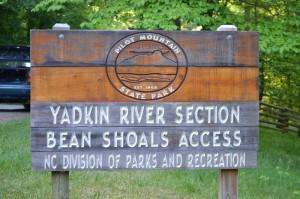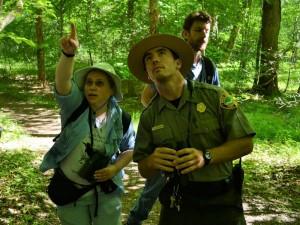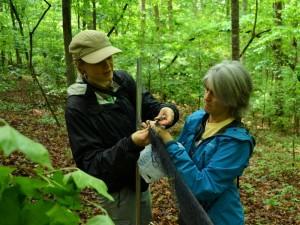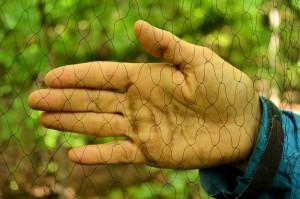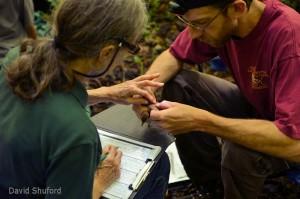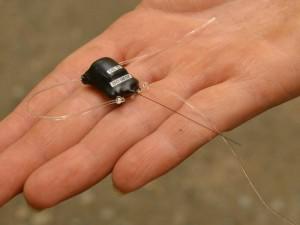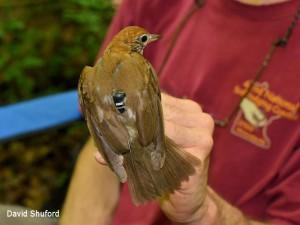Please welcome guest-blogger and member of Forsyth Audubon Kim Brand. This summer, Forsyth Audubon members helped researchers from the Smithsonian Migratory Bird Center capture, band and tag 22 Wood Thrush to record their migration habits. Read on to learn about the tracking project and the volunteers who participated in the event held in Winston-Salem.
Forsyth Audubon’s Wood Thrush Project is a collaboration with the Smithsonian and the International Alliances Program of the National Audubon Society, with support from Audubon North Carolina.
With small GPS units the size of a small backpack, researches can now track the migration path of the Wood Thrush to better understand where they spend the winter and how they get there. The event was held at the Pilot Mountain State Park IBA and Winston-Salem’s Bethabara Park.
The Yadkin River section of Pilot Mountain State Park is a wonderful place to see a Wood Thrush and listen to their beautiful, ethereal song. Because of their incredible presence, the Wood Thrushes’ songs can be heard anywhere in this area. Seventeen birds were trapped at the IBA, however there are plenty of Wood Thrush territories that we didn’t visit.
How to Track and Trap a Wood Thrush
Knowing where the birds are nesting makes it easier to catch them, and also increases the chances of catching a breeder rather than a non-breeding male, also known as a floater. Birds who regularly breed are more likely to return to the same area each year, which is very important to the success of our tracking project. In order to capture the data used to further research these birds, tagged Wood Thrush need to be recaptured once they’ve returned to nesting grounds in North Carolina.
In order to trap the Wood Thrush, Callie Stanley, a PhD student at the University of Maryland, who is researching the Wood Thrush for her dissertation, and Forsyth Audubon board member Kim Brand set up a mist net for catching the birds. Mist nets are very hard to see, so the birds won’t avoid them in flight. With the help of a song recording to attract the Wood Thrush to the nets, we had good luck catching and tagging them.
As you can see, the mist net is very fine!
GPS for Birds and People
Jean Chamberlain, a federally licensed songbird rehabilitator, helped out every day and was a huge resource in removing birds from nets and helping put the GPS backpacks on them.
This small GPS tag will record 50 locations over the next 12 months and is as accurate as the GPS in your car! Callie programmed the pack to record locations more frequently during migration and less frequently during the rest of the breeding season and winter, when the bird is likely to be more sedentary.
This Wood Thrush is wearing its GPS backpack, which is attached by elastic cord, like the kind used for making jewelry. This little guy is ready for release!
A Nationwide Effort
Peter Keller works for the Smithsonian and is traveling to three different sites this summer to trap and tag Wood Thrushes. North Carolina was his first stop. From there, he traveled to Bedford Audubon Society in New York, and on to Minnesota to work with St. Croix National Riverway staff. Each of these sites will help fill in the picture of migratory connectivity that illustrate the set of connections between breeding sites and wintering sites, letting us know which birds go where. The data recorded will also help identify the paths they take to get there.
Where it goes, no one knows, that is, until we recapture it next year!
Many of North Carolina’s Important Bird Areas provide breeding habitats for the Wood Thrush, a migratory songbird whose population is declining rapidly. For more information about our Important Bird Area program and conservation efforts to support the Wood Thrush, check back on the blog later this week!
All photos are by David Shuford, a longtime Forsyth Audubon member and Wood Thrush project volunteer.

